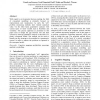Free Online Productivity Tools
i2Speak
i2Symbol
i2OCR
iTex2Img
iWeb2Print
iWeb2Shot
i2Type
iPdf2Split
iPdf2Merge
i2Bopomofo
i2Arabic
i2Style
i2Image
i2PDF
iLatex2Rtf
Sci2ools
ER
2007
Springer
2007
Springer
Improving Environmental Decision-making: Bridging the Gap between Conceptual Modelling and Quantitative Analyses with Quasta
With regard to environmental decision-making, the field of conceptual modelling is primarily focused on representation and visualisation. As such, the ‘soft’ problem structuring methods have limited analytical value. On the other hand, quantitative analyses with various types of ‘hard’ models lack in flexibility and versatility. The Quasta approach as presented in this paper aims to bridge the gap between soft and hard systems by allowing qualitative analysis on the basis of a purely conceptual model. The method can be used to identify the key elements to be modelled in a quantitative system, in order to address the problems as captured in the conceptual model.
| Added | 07 Jun 2010 |
| Updated | 07 Jun 2010 |
| Type | Conference |
| Year | 2007 |
| Where | ER |
| Authors | Frank van Kouwen, Carel Dieperink, Paul P. Schot, Martin J. Wassen |
Comments (0)

